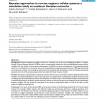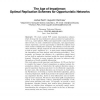85 search results - page 13 / 17 » A new measure of the robustness of biochemical networks |
VLSI
2010
Springer
14 years 10 months ago
2010
Springer
—Latency insensitivity is a promising design paradigm in the nanometer era since it has potential benefits of increased modularity and robustness to variations. Synchronous elas...
122
click to vote
BMCBI
2010
15 years 6 days ago
2010
nd: Gene regulatory network is an abstract mapping of gene regulations in living cells that can help to predict the system behavior of living organisms. Such prediction capability...
107
click to vote
BMCBI
2007
15 years 3 days ago
2007
Background: Reverse engineering cellular networks is currently one of the most challenging problems in systems biology. Dynamic Bayesian networks (DBNs) seem to be particularly su...
120
click to vote
CONEXT
2009
ACM
15 years 1 months ago
2009
ACM
: We study mobile P2P content dissemination schemes which leverage the local dedicated caches provided by hand-held devices (e.g., smart-phones, PDAs) and opportunistic contacts be...
104
click to vote
RECOMB
2003
Springer
16 years 12 days ago
2003
Springer
We develop a new framework for inferring models of transcriptional regulation. The models in this approach, which we call physical models, are constructed on the basis of verifiab...


